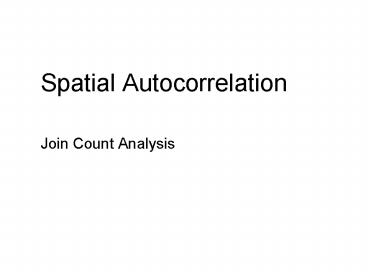Spatial Autocorrelation - PowerPoint PPT Presentation
1 / 12
Title:
Spatial Autocorrelation
Description:
Join Count. Nominal variables mapped in two colors (B & W) ... Therefore, if there are L joins on a map, the expected number of cells of each type is ... – PowerPoint PPT presentation
Number of Views:36
Avg rating:3.0/5.0
Title: Spatial Autocorrelation
1
Spatial Autocorrelation
- Join Count Analysis
2
Join Count
- Nominal variables mapped in two colors (B W).
Therefore, the join, or border can be classified
as WW, BB, BW - Different Join Patterns
- Rooks Case
- Queens Case
- Bishops Case
3
Join Counts
BB
WW
BW
Tot.
Map
4
Computing the Joins
- When using a computer to compute joins, we will
have twice as many joins (ex. WB, BW). Just
divide by two - If we have nb Black cells and nw n nb white
cells the probability p of a black cell is - pb nb /n
- pw nw /n
5
Computing the probabilities
- Start with first cell. The probability it is
black is pb and the probability of white is pw - The probability of BB in two adjacent cells is
- pb pb or pb2
- Probability of BW is
- pb pw pb pw or 2 pb pw
6
- Therefore, if there are L joins on a map, the
expected number of cells of each type is - E(BB) m(BB) pb2L
- E(WW) m(ww) pw2L
- E(BW) m(BW) 2pbwL
7
Test Statistics for Join-Count
8
(No Transcript)
9
Example from Election 2000
- A spatial analysis of Election 2000
- Did the blue and red map really say something
significant about the locations where people
voted by County? - ArcView example
10
(No Transcript)
11
(No Transcript)
12
(No Transcript)































